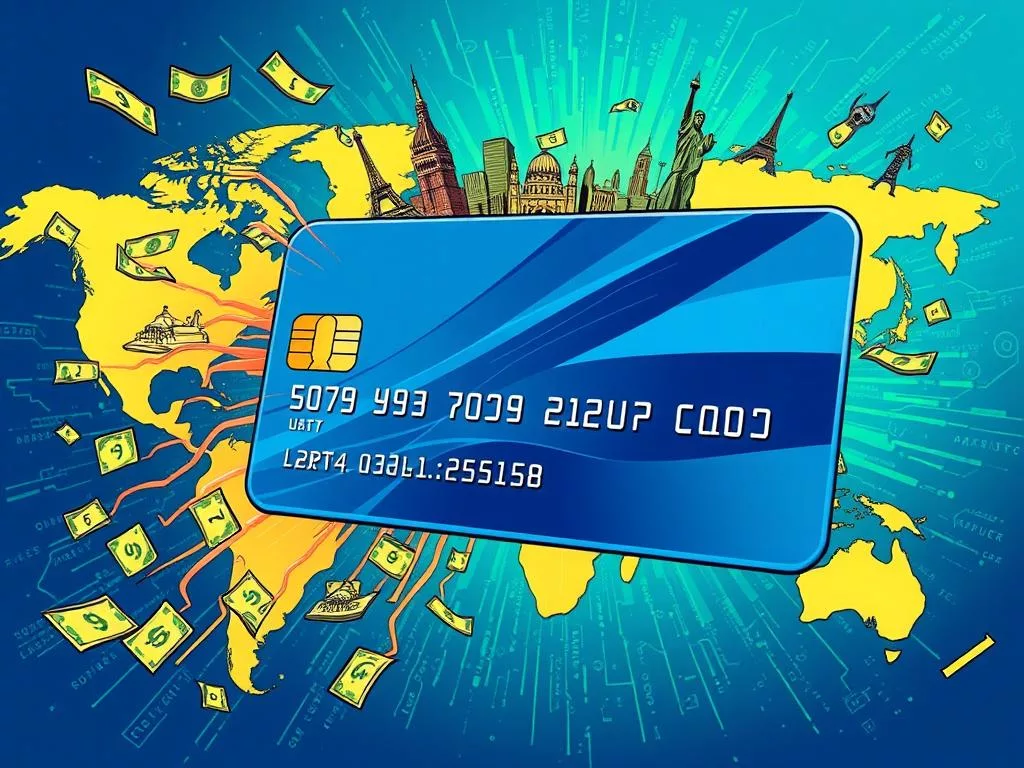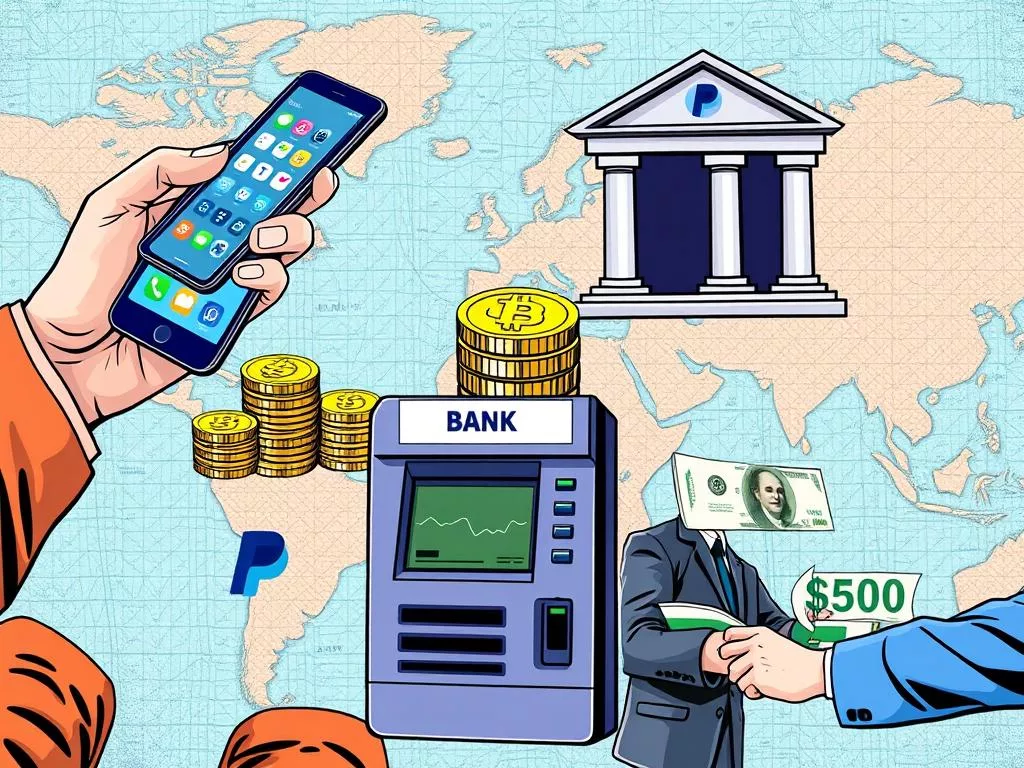In today’s global economy, sending money abroad is common. It’s for family support, paying services, or sending gifts. Credit card international transfers are a convenient way to do this.
The World Bank’s June 2024 report shows banks charge high fees. This makes platforms like Wise a cost-effective option. With over 12.8 million users, Wise can save us a lot compared to banks.
Wise offers quick transfers and clear fees. Knowing how to use credit cards for these transfers can be very helpful.
Understanding Wire Transfers and Credit Cards
Wire transfers are a fast way to send money from one bank to another. When sending money abroad, a wire transfer to an international account is used. These transfers can have fees, which depend on the bank. You might pay the fees or the person you’re sending money to.
Credit card transactions, like wire transfers, are often seen as cash advances. They come with higher fees and interest rates. For example, transferring $500 could add $25 in fees.
While credit card wire transfers seem easy, they can be costly. It’s key to understand the fees and interest rates. The Schumer Box in card agreements shows these details. This helps avoid the downsides of using credit cards for international money transfers.
| Transfer Type | Fees | Interest Rate | Speed |
|---|---|---|---|
| Bank Wire Transfer | Average $45 | Standard APR | 1-3 business days |
| Credit Card Transfer | $10 or 5% (+Cash Advance Fee) | Higher than purchase APR | Instant posting |
| Wise Transfer | Less than 1% (upfront fee) | No interest charges | Same-day (varies by country) |
| OFX Transfer | No transfer fees | Markup 1.35% to 4.50% | 1-3 business days |
There are many ways to send money, including online services and debit cards. Knowing these options helps me make better choices when sending money abroad.
Can you use a Credit Card to Send Money Overseas?
Yes, you can send money abroad with a credit card. But, it’s important to know a few things. Services like Wise let you do credit card international transfers. Yet, they don’t take American Express.
Using a credit card for money transfers can be pricey. There are many fees that add up fast. Also, Xoom and Western Union offer wire transfers with credit card. These can be quick, but the costs and rates differ a lot.

When using a credit card abroad, extra fees might apply if you don’t pay in local currency. It’s key to update your bank info before traveling. This way, they can contact you if needed.
Withdrawing cash with your credit card abroad can lead to cash advance fees. This makes it less appealing. If your card is lost or stolen, having the bank’s overseas contact number is vital for quick action.
Setting up automatic payments for bills while away can prevent missed payments. Having another payment method ready, like a debit card, is also wise. Some services limit credit card payments by country or currency, adding complexity to international transfers.
Credit cards are often seen as an expensive way to send money. They come with cash advance fees, interest, currency conversion fees, and more. For example, PayPal charges a 2.9% fee plus $0.30 for domestic credit card payments. Cash App takes a 3% fee for UK to USA transactions. So, while credit card transfers are possible, it’s wise to weigh the costs and risks first.
| Provider | Transaction Fee | Currency Conversion Fee |
|---|---|---|
| PayPal | 2.9% + $0.30 | Variable based on the rate |
| Cash App | 3% (international) | Not specified |
| Western Union | Variable | Variable based on the rate |
| Xoom | Variable | Variable based on the rate |
Costs Involved in Sending Money Overseas
Sending money abroad can be expensive. Banks often charge $35 to $50 for international wire transfers. Domestic wire transfers might cost $20 to $35. Incoming wire transfers can cost from $0 to $16.
Exchange rates are also important. In March 2021, 1 USD was about 0.83 EUR. Banks often add a markup to these rates, affecting the amount received. The World Bank says sending money abroad costs about 6% of the transfer amount.
Services like Western Union might have lower fees than banks. But their fees change based on the method used. Faster services cost more, while slower ones are cheaper.
Credit card transfer fees vary by provider. Some charge a flat rate, others a percentage of the amount transferred. Here’s a table showing average costs for different transfer methods:
| Transfer Method | International Transfer Fee | Exchange Rate Markup | Typical Duration |
|---|---|---|---|
| Traditional Bank Wire Transfer | $35 – $50 | Up to 3% | 1-5 days |
| Western Union | Varies by location | 0.5% – 2% | Minutes – 1 day |
| Wise | Typically | Market Rate | 1-3 days |
| Credit Card Transfer | Flat or % based | Varies | Instant – 1 day |
Choosing the right provider can save money. Some offer fee waivers for new customers. Online currency transfer firms often have better rates than banks. Look at transfer method, amount, speed, and fees to save money when sending money abroad.
Alternatives to Sending Money with a Credit Card
Looking into other ways to send money can save a lot. Services like Wise, OFX, MoneyGram, and Xoom offer cheaper options than credit cards. They have lower fees and better exchange rates, making money transfers faster and cheaper.
Wise is known for its clear fees and good exchange rates. This means I can send money cheaper than with banks. OFX is great for sending USD without fees, and it’s quick, often the same day.
MoneyGram and Western Union let you pick up cash, which is good for those without bank accounts. Apps like PayPal also make quick transfers, but fees and safety can vary. It’s key to pick the right service for your needs.
But, sending money with credit cards has downsides. It can cost a lot because of cash advance fees. Using direct debit with OFX can avoid extra costs.
Here’s a look at some popular alternatives to credit card transfers:
| Service | Transfer Fees | Transfer Time | Exchange Rates |
|---|---|---|---|
| Wise | Low, transparent fees | 1-2 business days | Mid-market rates |
| OFX | Fee-free for USD transfers | Same day or 1-2 business days | Customized rates for large transfers |
| MoneyGram | Varies by location | Instant with cash pickup | Variable |
| Western Union | Varies by location | Instant with cash pickup | Variable |
| PayPal | Varies by destination | Instant transfers | Varies by account |
Picking the right service can cut costs and speed up sending money abroad. Looking at these options helps find the best fit for you.

Advantages of Using a Credit Card for International Transfers
Using a credit card for international transfers has many benefits of credit card transfers. The first big plus is how easy it is to send money overseas. I don’t have to carry cash or find local banks. Credit cards make quick money transfers simple and fast.
Many credit card companies use new tech to make things better for users. For instance, some issuers have fraud detection that knows when I’m traveling. This means I don’t have to tell them my plans. It makes buying things abroad easy and worry-free.
Security is another key plus. Cards with chip-and-PIN tech are safer, which is common in Europe. My credit card company might also change foreign money to my home currency. This makes things even simpler.
Also, some cards, like One Credit Card, offer great rewards for international use. I can earn points and get better exchange rates. Here’s a comparison:
| Credit Card | Forex Markup Rate (%) | Rewards Program |
|---|---|---|
| One Credit Card | 1 | 5X on Top 2 Categories |
| Standard Market Rate | 3.5 | None |
These points show why advantages of credit card payments are so strong for international transfers. With new tech and apps like Wise, handling payments abroad is now easier than ever.
Disadvantages of Using a Credit Card for Overseas Transfers
Using a credit card for overseas transfers has big downsides. One major problem is the fees of credit cards. These fees can be very high, making it less appealing for international deals.
Interest on cash advances starts right away. This can add up fast, leading to higher costs. Also, exchange rate markups can increase what you pay, highlighting the risks in using credit cards for transfers.
Travel credit cards often come with an annual fee. There are also fees for foreign currency transactions, charged as a percentage. I’ve seen that cash withdrawals abroad can have high fees too.
Here’s a quick rundown of the main drawbacks I’ve found with credit cards for international transfers:
| Disadvantage | Description |
|---|---|
| High Interest Rates | Credit cards often have very high interest rates. |
| Annual Fees | Many cards come with an annual fee. |
| Foreign Transaction Fees | There’s usually a fee for using cards in foreign currencies. |
| Cash Withdrawal Fees | ATM and card fees for cash withdrawals abroad can be very high. |
| Document Requirements | Credit card providers might ask for ID and proof of income. |
Given these disadvantages of credit card transfers, I suggest looking into other options. Travel cards or money transfer services might be more cost-effective and transparent. For more on the pros and cons of credit cards abroad, read this article here.
How to Save Money When Sending Money Overseas
Sending money abroad can get pricey if you don’t plan right. It’s key to look at different options and pick the best one. Wise is a top choice for saving money, with fees under 1% when you use a bank account.
Using services like OFX can even get rid of transfer fees. This is great for anyone wanting to cut costs.
Credit cards might seem easy to use, but they can cost a lot. Staying away from credit cards can save you money. Some cards don’t charge extra for foreign transactions, which is a plus.
Knowing how much each service charges is important. For instance, some banks might take up to 13.40% of your money for international transfers. But, Western Union offers same-day delivery with debit cards for less.
- Consider alternatives like OFX that provide fee-free transfers for USD.
- Look for services with low upfront fees, such as Xoom.
- Explore local payment options to enhance savings.
- Opt for accounts with high APY, such as cash management accounts, to maximize your funds.
By keeping an eye on fees and choosing wisely, you can save on money transfers. This way, you can send money abroad without breaking the bank.
Safety and Security in International Money Transfers
Keeping money transfers safe is a top priority. I trust services like Wise and OFX for their strong data protection and fraud prevention. They make sure my money is safe during international transactions. Plus, their 24/7 customer support helps me solve any issues fast.
But, I also watch out for online scams to keep my transactions safe. It’s important to use services that follow laws like Anti-Money Laundering (AML) and Know Your Customer (KYC). This way, I can send money abroad without worries.
While credit cards are convenient, I know delays can hurt my credit score. So, I choose platforms like moneyHOP that are clear about fees and secure. Knowing my options helps me protect my money when sending it across borders.

